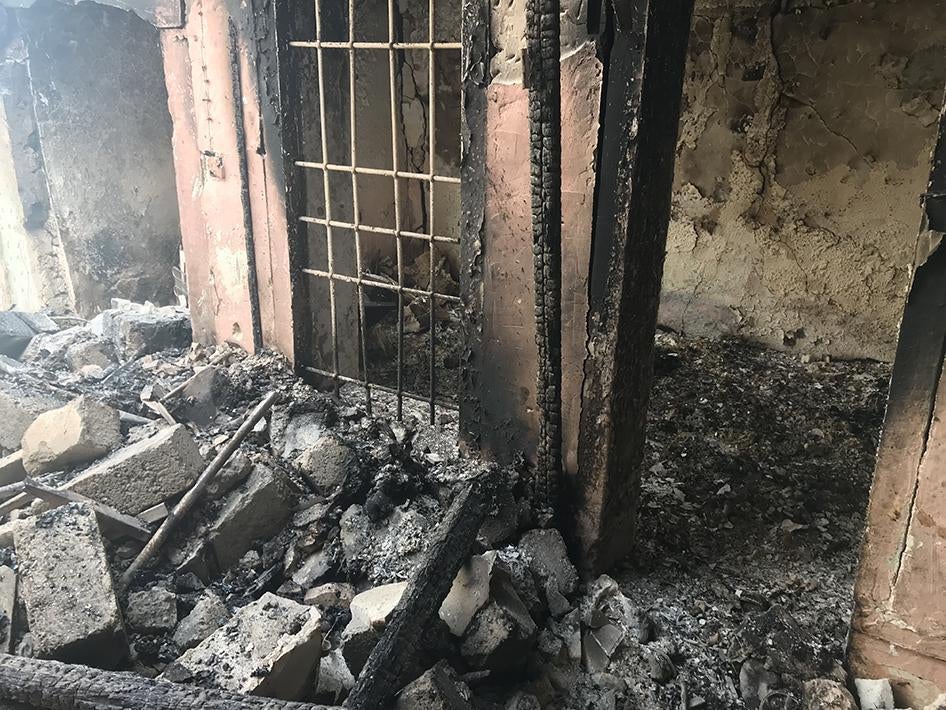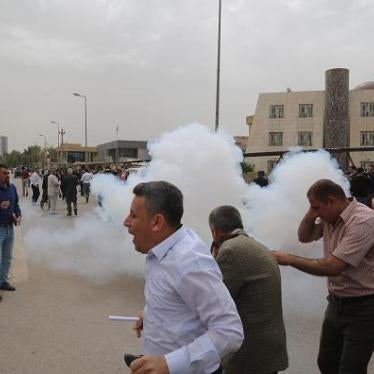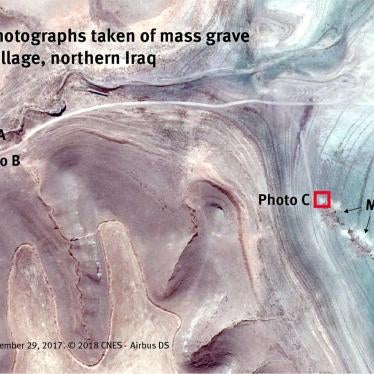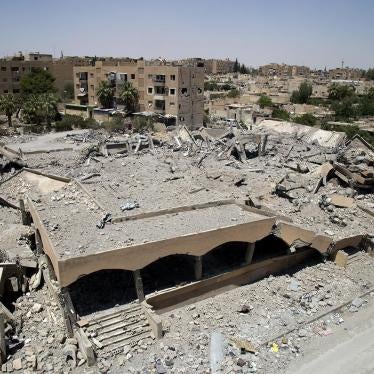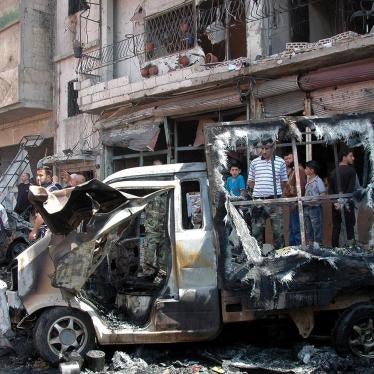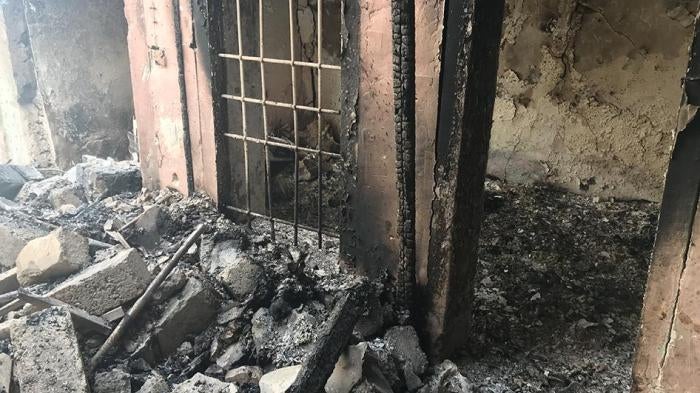
(Erbil) – An incident on March 29, 2018, in which government workers removed about 80 bodies from a damaged house, raised suspicions of a cover-up of killings of possible Islamic State (also known as ISIS) suspects, Human Rights Watch said today. Human Rights Watch observed the episode. Days later, the house had been burned.
Iraqi authorities at the site said they were the remains of ISIS suspects. Heath Ministry and Interior Intelligence Ministry officials at the site said they were not permitted to share information about where the bodies were taken. There has been no indication that the deaths are being investigated.
“Given the serious abuses in the final weeks of the battle against ISIS in Mosul’s Old City, this site and the bodies should have been preserved as potential evidence for forensic investigators,” said Lama Fakih, deputy Middle East director at Human Rights Watch. “Prime Minister Haidar al-Abadi promised to investigate these possible war crimes, but with no tangible results almost a year later, the actions of his own officials at this site speak louder than words.”
Iraqi forces retook Mosul’s Old City from ISIS in July 2017. Human Rights Watch documented Iraqi forces rounding up ISIS suspects, torturing and then executing them that month near that site. Some of these forces were from an Iraqi army division trained by the United States government. During the same period, four videos on Facebook allegedly filmed in west Mosul also appear to show Iraqi soldiers and federal police beating and extrajudicially killing detainees.
In September, al-Abadi’s office announced a special committee was being established to investigate abuse and subsequently, in September, said soldiers guilty of abuses in the context of the battle against ISIS were being held accountable. Despite multiple inquiries, however, Human Rights Watch has been unable to obtain information about the outcomes of the investigations and has found no evidence of any officers being held accountable for abuses in the Mosul operation.
Human Rights Watch researchers, alerted by a medical worker in the area on March 29, entered the damaged house and found a room full of human remains. Municipal officials, along with Health Ministry and Interior Intelligence Ministry officials, were at the site. Three people who told Human Rights Watch in July 2017 about seeing torture and executions in the Old City said after the March 29 episode that this house was very close to where they had seen Iraqi forces capture and hold ISIS suspects.
Health Ministry officials placing the corpses in body bags estimated that there had been 80 to 100 bodies in the room. A contractor with Mosul’s Municipality and the Health Ministry hired to clear rubble and bodies from the neighborhood said that Health Ministry staff had cleared 40 remains of what looked like adult men from the room on March 28 and an estimated 40 or so more on March 29.
The bodies were piled up and badly decomposed so researchers could not make out the cause of death without disturbing the site. At least one body appeared to have its legs bound. There were no ballistic markings on the walls or blood splatters, indicating that the bodies were placed there after death. There was nothing to suggest that Iraqi authorities were treating the site as a crime scene. No police or other investigators were there, and workers removing the bodies did not appear to be gathering evidence. Health Ministry officials were pulling out the remains and putting them into body bags for municipality staff to drive away.
Human Rights Watch wrote to the Human Rights Committee in the Prime Minister’s Office on April 17 asking whether there had been efforts to identify the dead and cause of death, whether an investigation had been opened, and where the corpses had been taken. There has been no response.
When Human Rights Watch asked a Health Ministry official at the site where the bodies were being taken and what they were going to do with them, the official responded aggressively and said authorities were forbidden to share that information. Researchers called a Mosul municipality engineer to ask the same question and he said that intelligence officers had told him and other staff not to provide that information. Officials at the site told Human Rights Watch they could not photograph the bodies.
On April 4, Human Rights Watch researchers returned the site to find that the remaining corpses had been removed and the room had been burned out, leaving no traces of the corpses. No one asked knew who burned the site.
An international forensics expert told Human Rights Watch that in some countries, he has seen burning used to rid areas with corpses of disease, particularly if people live nearby, or to symbolically cleanse a location. However, he did not know of any previous instances in Iraq.
On August 17, 2017 following the Human Rights Watch reports of abuses in the Mosul battle, the Prime Minister’s Office issued a statement that it had established a committee to investigate over 20 allegations of abuse during the Mosul operation. It stated that they had arrested several of the officers, who were facing trial.
On September 17, al-Abadi stated that initial investigations found that the abuses were by individuals, not “systematic.” He told the Associated Press that soldiers found guilty were being held accountable and “at the moment we are listening to all reports, to all claims, there is no indication that this is a systematic abuse of human rights.” He said the officers involved were largely being charged with “negligence,” unless they were found to have issued orders to commit abuses.
The authorities have not published any information regarding judicial proceedings against any soldiers or officers beyond general statements that investigations are underway and forces are being held accountable.
On April 4, researchers told the head of the Nineveh Appeals Court about the bodies, but he insisted that the men must have been killed during the fighting and indicated no concern over finding bodies of suspected ISIS members, even a in large number. He said that when bodies of suspected ISIS members are found, the court issues a death certificate, with no investigation into the cause of death.
Prime Minister al-Abadi should promptly make public the results of investigations his government has carried out into abuses during military operations against ISIS, including in Mosul, including details of the specific cases. He should order Mosul municipal officials to publicly release information about where the bodies seen on March 29 were taken and allow forensic experts to examine them.
He should also order a halt to body clearance elsewhere in the Old City until forensic examinations have been carried out in cases in which it appears a crime has been committed, and promise to make the results of these investigations public.
“If Abadi wants to signal a change in Iraq’s culture of impunity for forces committing the most horrific abuses, he should take concrete steps to protect possible evidence of war crimes, and bring in forensic experts to investigate before it is too late, in a transparent and public manner,” Fakih said.
